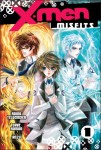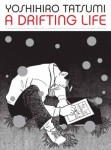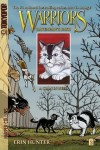Manga or Not Manga? That is the Question
Continuing at #1 on the NYT Manga best seller list this week is Warriors: Clan in Need, the new title in the wildly popular series (which is also popular in its prose format). Meanwhile, the manga-influenced version of another wildly popular title, Twilight is #1 on the Hardcover list.
So, why is Warriors on the Manga list, while the manga-influenced Twilight is not? These placements highlight a debate among comics and manga readers as to how to best define manga for the US readers. Manga is simply the Japanese word for comics but it has evolved to define a particular style. What constitutes that style, however, is highly debatable. Some say it should only include titles originally published in Japan by Japanese creators. Others expand the definition to include manga-influenced titles, like both Warriors and Twilight. This then raises debate about how many manga elements a title needs to include (the Graphic Novel Reporter gives a good rundown of manga style). Does only art style come into it, or should the other aspects of manga including symbols, pacing, and storytelling techniques be necessary?
But, in the end, readers don’t care so much about these distinctions; they just want to know if particular titles appeal to fellow manga fans. Dramacon by Svetlana Chmakova is a US-produced title that is beloved by manga fans because it adopts not only the visual style but also the intricacies of symbols, pacing, and layout that make manga a recognizable art form. The popular series Megatokyo and stand-alone works like June Kim’s 12 Days occupy a more complex middle spot between manga and western comics sensibility.
On the other hand, the Warriors graphic novels are not particularly appealing to manga fans (they’re appealing to Warriors fans, but that’s a whole other kettle of fish).
I am a librarian who believes, for the purposes of creating lists and organizing collections, it’s easiest to define manga strictly as comics produced in Japan for a Japanese audience. Once you start including titles from outside Japan as manga, it becomes increasingly difficult to determine a line between manga and non-manga. As art styles and influence grow more intermingled, it is problematic to leave the term up to individual tastes or publisher’s marketing schemes. The most important thing, however, is consistency, something which is not happening on the New York Times lists.
 The Warriors series has appeared on the manga list multiple times, as have other US created manga-style series including Vampire Kisses: Blood Relatives from Ellen Schreiber and Maximum Ride by James Patterson. On the other hand, Scott Pilgrim, a series with marked manga influences, appears on the softcover lists, as does Adam Warren’s Empowered and X-Men: Misfits, both of which are clearly manga-style in terms of art.
The Warriors series has appeared on the manga list multiple times, as have other US created manga-style series including Vampire Kisses: Blood Relatives from Ellen Schreiber and Maximum Ride by James Patterson. On the other hand, Scott Pilgrim, a series with marked manga influences, appears on the softcover lists, as does Adam Warren’s Empowered and X-Men: Misfits, both of which are clearly manga-style in terms of art.
How does the NYT decide what is manga and what is not? It seems they simply take the publishers word for it. If a publisher calls a title “manga” it goes on that list; when a title has no designation, it goes on either the hardcover or paperback lists.
 As a result, sometimes true manga titles don’t appear on the manga list. Last year, A Drifting Life by Yoshihiro Tatsumi, a stunning memoir by one of the founders of gekiga, or dramatic manga aimed at adult men, showed up on the softcover list, with no indication that the list makers realized that it was manga. Even more troubling, Death Note: L Change the World appeared for many weeks on the manga list even though it is a prose novel and thus not even a graphic novel. Death Note is indeed a best-selling manga series, but L Change is a novel spin-off, and its continued placement on a graphic novel best seller list made it appear that the New York Times list makers weren’t quite paying attention.
As a result, sometimes true manga titles don’t appear on the manga list. Last year, A Drifting Life by Yoshihiro Tatsumi, a stunning memoir by one of the founders of gekiga, or dramatic manga aimed at adult men, showed up on the softcover list, with no indication that the list makers realized that it was manga. Even more troubling, Death Note: L Change the World appeared for many weeks on the manga list even though it is a prose novel and thus not even a graphic novel. Death Note is indeed a best-selling manga series, but L Change is a novel spin-off, and its continued placement on a graphic novel best seller list made it appear that the New York Times list makers weren’t quite paying attention.
In selecting, we need to be aware that all the titles on the manga list may not appeal to manga fans. Buying Warriors or Vampire Kisses will not be a way to satisfy your readers’ demand for more manga.



April 9th, 2010 at 2:36 pm
I understand what you’re saying! I’m a big fan of all types of manga–Japanese manga, OEL manga, manhwa–and it’s so hard to explain to people the differences between them. As an artist, I can explain it a little better, but most people I know don’t like anything but Japanese manga. If it’s not by a Japanese name, they just wish it to be part of a graphic novels’ list. But I wouldn’t think that the New York Times Bestsellers list would only take the publishers’ word if they’re manga or not. It just seems so incredible. Still, great article! I really connected with it.
April 9th, 2010 at 3:03 pm
I think your way is best: If it’s from Japan, it’s manga. If it’s not from Japan, it’s not.
That said, I did code re: Play as manga because it came from Toykopop and clearly was meant to be taken as a manga. If I had to code it again, I’d probably take the tag away.
I mean, I bet we could sit here all day and debate the manga-ness of Scott Pilgrim, Blue Monday, Empowered, and the like. I prefer to refer to them as Western Comics who have a strong manga influence. The NYT could do worse than to adopt the same.
April 9th, 2010 at 10:24 pm
[…] which is on the list for the 10th week—does nobody read my reviews?? At Early Word, Robin Brenner questions the inconsistencies in the list, noting that L: Change the World, a light novel, made the list but Yoshihiro […]
April 11th, 2010 at 4:38 am
[…] But why isn’t it considered manga? Robin Brenner of Early Word and Librarian Extraordinaire looks at just that question. Warriors: Clan in Need vanishes from the list completely after only 1 week, […]
April 11th, 2010 at 3:56 pm
I’m glad the article hit home with you, Jade! I honestly can’t decide if the New York Times is just unaware of the nuances (which is possible, as they took many many months to bring in anyone to comment on the manga lists) or if they’re deciding by some code only they know.
I think it’s a tricky question as to what is manga or not — or perhaps more accurately what should be called manga or not. I have friends and colleagues who firmly believe that manga influence comics (Dramacon and Nightschool, Re:Play, Blue Monday, etc.) should be called manga. I do think, as you say, have an artistic or strong visual imagination can make the distinctions more obvious. I am both, and I think I may notice manga’s visual components more closely, and therefore have more issues when it’s done part one way and part another. One does wonder, though, how much readers care now and how much they will care in the future as manga’s style and pacing and storytelling is such a strong influence on comics creators now.
April 11th, 2010 at 3:57 pm
Rob, I think what I’d like at the very least is some sort of reasoning or statement about how they decide what is manga and what isn’t. As long as those who follow the lists know where they’re coming from, they can do what they like, really. But yes, I’d prefer consistency and a clear reasoning as to why different titles belong on different lists.
May 21st, 2010 at 11:37 am
I think your way is best: If it?s from Japan, it?s manga. If it?s not from Japan, it?s not.